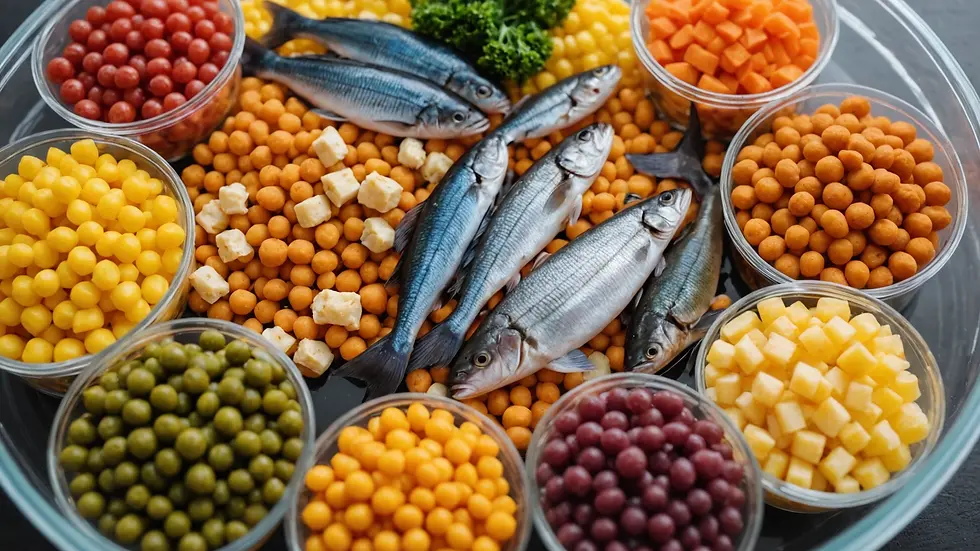What Do You Need to Know About Meeting the Dietary Needs of Breeding Fish?
- Jyotiraj Borah
- Feb 8
- 4 min read
Breeding fish can be an exciting and fulfilling hobby or business venture. However, successful breeding hinges on a solid understanding of the dietary needs of both breeding pairs and their fry. Proper nutrition is essential to ensure that fish are healthy parents capable of producing viable eggs and fry.
In this post, we will delve into the dietary needs of breeding fish, exploring essential nutrients, effective feeding strategies, and common mistakes to avoid.
Understanding the Nutritional Requirements of Breeding Fish
Breeding fish have specific dietary needs that differ from those kept for ornamental purposes or as pets. To support successful reproduction, fish require a diet rich in proteins, fats, vitamins, and minerals.
Proteins: The Building Blocks of Life
Proteins are vital for fish growth and development. They aid in tissue development, immune function, and hormone production, all crucial during breeding.
Most breeding fish thrive on a diet containing between 30% to 50% protein, depending on the species. High-quality protein sources, like fish meal and shrimp meal, should be prioritized as they provide all essential amino acids. For example, species like the Betta fish benefit significantly from diets with high-quality fish meal, which can enhance their breeding success rates by over 20% compared to lower-quality options.
Lipids: Energy Sources for Reproductive Health
Lipids, which include fish and certain plant oils, are critical for energy levels essential for spawning.
Including diverse dietary lipids can boost egg production and fry development. Breeding fish typically require a fat content of around 10% to 20%. For instance, adding fish oil can assist female fish in producing healthier eggs, enhancing hatching rates by approximately 25%.
Vitamins and Minerals: Micronutrients for Vital Functions
Vitamins and minerals play significant roles in fish health. Vitamin A supports reproductive health, while Vitamin D is essential for calcium metabolism, crucial for fry development.
Key minerals such as calcium and phosphorus support bone development. It is important to provide a balanced vitamin and mineral supplement to ensure both adults and offspring remain healthy. Research shows that fish provided with adequate vitamins and minerals exhibit growth improvements of up to 30% during their breeding cycles.
Specifying Diets for Diverse Species
Different fish species have unique nutritional needs. Understanding these can lead to improved breeding outcomes.
Tropical Fish
Tropical fish, like guppies and mollies, thrive on high-protein diets. They benefit from live foods such as brine shrimp and daphnia, alongside high-quality commercial pellets. For example, guppies fed high-protein diets show significantly increased fry production.
Goldfish
Goldfish require a lower protein diet. They should be fed a mix of plant-based foods to prevent health issues caused by overfeeding, such as swim bladder problems. Moderation can ensure their health and reproduction are optimized.
Cichlids
Cichlids are known for their aggressive feeding habits and require high-protein diets. A balanced blend of pellets, live foods, and frozen offerings can meet their nutritional needs effectively.
Feeding Strategies for Breeding Fish
When feeding breeding fish, the quantity, frequency, and type of food can each influence breeding success.
Feeding Frequency
During the breeding season, fish may need to be fed more frequently to meet increased energy and nutrient needs. Feeding them 2 to 4 times a day ensures they receive necessary nutrients for successful breeding.
Quality Over Quantity
While quantity matters, the quality of the food plays a crucial role. Providing smaller amounts of high-quality food is better than offering larger portions of low-quality options, which can lead to health problems and lower reproduction rates.
Introduce Variety
Rotating food types can effectively meet the dietary needs of breeding pairs. A mix of live, frozen, and dry foods is recommended to keep fish interested while covering all nutritional bases.

Common Pitfalls in Fish Nutrition
Recognizing common mistakes in fish feeding can optimize their dietary needs for breeding.
Overfeeding
Overfeeding can lead to water quality issues that negatively affect fish health. Closely monitor feeding amounts and adjust according to the specific needs of the fish.
Poor Quality Food
Low-quality foods may lack vital nutrients or contain harmful fillers. Research brands and select specialized diets designed to meet breeding conditions for the best outcomes.
Ignoring Water Quality
While diet plays a critical role, water quality is equally important for fish health and breeding success. Implement regular water changes and quality checks as part of your dietary management strategy.
Unique Considerations for Fry Nutrition
After spawning, the focus shifts to the nutrition of fry, which require specific diets for survival and growth.
First Foods for Fry
Fry are typically very small and need tiny food particles. Great initial food options include infusoria and specially designed fry foods tailored for their size and needs.
Gradual Transition
As fry grow, gradually introducing larger food particles can support their growth and development. Monitor this transition carefully to avoid choking hazards or excessive waste.

Innovations in Fish Diets
The field of aquaculture is evolving, with new feeding options continually emerging to meet the dietary needs of breeding fish.
Commercial Fish Foods
Many manufacturers now offer specialized breeding foods that are balanced for optimal reproductive performance. These pelleted foods can save time for fish breeders and provide a reliable nutrient profile.
Plant-Based Options
With growing awareness of sustainability, some aquarists are testing plant-based diets for breeding fish. Ingredients like spirulina and algae provide rich nutrient profiles that can benefit fish health.
Supplemental Feeding Strategies
Utilizing feeding stimulants can enhance fish feeding responses and improve their dietary intake. Research indicates that these stimulants can also boost growth rates in fry.
Final Insights on Feeding Breeding Fish
Successfully meeting the dietary needs of breeding fish requires more than just providing food. It involves understanding their specific nutritional requirements, adopting effective feeding strategies, and making necessary adjustments throughout the breeding cycle.
By focusing on diet quality and introducing variety, fish breeders can improve the health and reproductive abilities of their fish. A well-fed breeding pair is more likely to produce healthy and viable offspring.

In summary, achieving success in breeding fish goes hand in hand with a thorough understanding of their dietary needs. By applying the insights discussed here, breeders can enhance breeding outcomes and foster a successful aquaculture experience. Keep gaining knowledge about fish nutrition, and adapt to the unique needs of the species you are raising. Happy breeding!




Comments